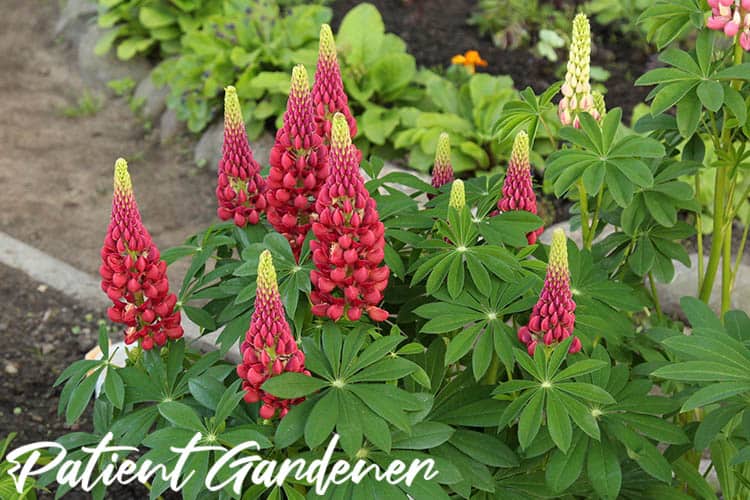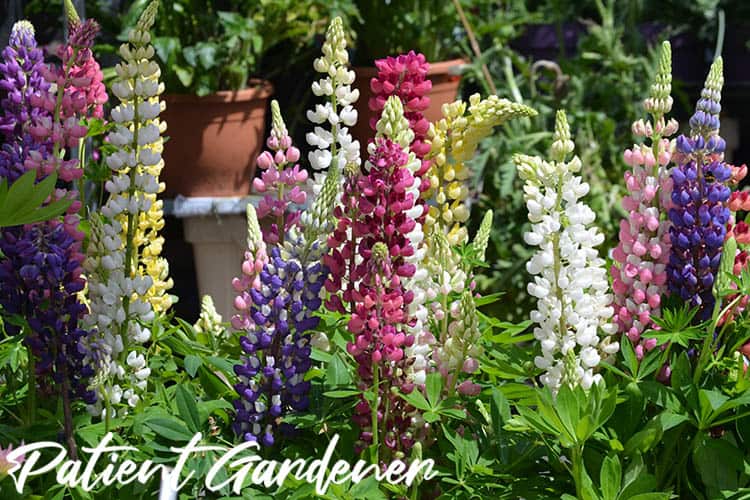When to plant lupins?
Ahh lupins, the cottage garden favourite. These plants seem to be a staple of British gardens despite originally hailing from the Mediterranean. They seem to thrive in our conditions and the flowering spikes are truly beautiful.
If you are planning to grow your own lupins from seed or from plants bought from the garden centre then you will no doubt be wondering when to plant your lupins? Well as it happens I have quite a bit of experience growing lupins, so I have written this guide to help you grow and more importantly know when to plant your lupins.

When to plant lupins
Lupins should be planted out in the garden from the first week of May onwards. You should harden off any young plants for a couple of weeks before transplanting them into the garden.
Lupins will grow quite happily in a pot so you should be in no rush to move them outside too soon, a cold frost can be damaging to a young lupin. Although more established lupins are very hardy and can survive a winter outside just fine young lupin seedlings do need a little more care and attention.
You just need to make sure the pot is big enough to allow the lupin to continue to grow. Lupins will grow to their post size so don’t leave them in a tiny pot or you may stifle their growth.
A 10cm pot or above should be enough to allow the lupin to grow freely before being planted out.

Just to give you an idea of what pot size can do to a lupin here is an experiment I recently did with a couple of lupins.
Both of these plants were grown from the same batch of seeds at the same time. This photo was taken in April after they had been in pots for over a year.
You can really see the huge difference in size just from the difference in their respective pot sizes. This is not likely to be a problem for you as you will probably be planting them out but just don’t leave the lupin seedlings in a seed tray or small pot for too long.
Slugs and Snails
Beyond just the time of year and the weather conditions being right you also need to ensure your seedlings are big enough and tough enough to deal with living outside.
The tough enough part is easy enough, simply harden the plants off by moving them outside for longer and longer periods over a couple of weeks.
The big enough problem though really just takes time. You want to make sure your young lupins have grown quite large before you plant them out. The main reason for this is quite simple, slugs love lupins. And if your plant is quite small you can often find that the whole thing disappears overnight.
If the plant is larger it is more likely to stand up to some slug munching and survive and put on lots of new growth.

I like to wait until they are well established, maybe a little larger than the ones in the above photo before planting them out into the big wide world.
When to sow lupins
If you are planning on growing your lupins from seed then you will need to know when to sow them before you can even think of planting them out!
Soak the seeds
Soak your lupin seeds in water the night before you intend to plant them, this will aid in the germination process.
Sow in seed trays
I always like to sow lupins in seed trays. You can use any general compost and begin sowing in middle to late February. Sow in a greenhouse or on a window sill if sowing in early spring.

If sowing later in the year you can try sowing directly to the ground although I have never used this method.
One easy way of sowing lupins is to sow direct into the soil in the autumn or winter for growth next year. Lupins are self-seeders so this is essentially mimicking their natural cycle and they normally do quite well when grown like this.
More on Lupins
Lupins are a beautiful flower that you will find in many British gardens. Lupins are a staple of British cottage gardens, famed for both their height and colour. Originally hailing from the Mediterranean they are a perennial that will greet you with a gorgeous display year after year.

They produce a large flowering spike that is full of colour and each plant can have lots of these spikes leading to a fabulous display. They will begin to flower around may and can last well into June. The flowers do go to seed quite quickly but your lupin will continue to produce more and more new spikes.
To get the best out of these spikes though it is essential to deadhead the old spikes to give the new ones a chance to flourish. Also cutting your lupins back in autumn can help them the following spring. The seeds are edible but if not treated properly first they can be poisonous to animals and humans. Greenfly can be a common problem for lupins here in the UK.






